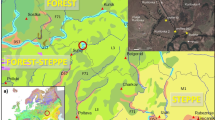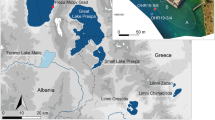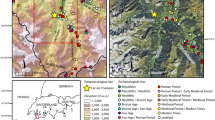Abstract
Pollen analyses of sediment cores from two small lakes within the boreal forest in the central Scandes Mountains help to elucidate the Holocene forest dynamics of the region. Analyses of pore/pollen grain diameter ratios of Alnus grains indicate the early Holocene presence of Alnus glutinosa in the study area. The results are discussed in conjunction with available pollen records to evaluate the importance of thermophilous trees during the early Holocene and to deduce the regional spread of Picea abies. Corylus avellana, Alnus glutinosa and Ulmus glabra were probably common constituents of the early Holocene forest. Tilia cordata may have occurred there as a rare tree. Pollen stratigraphies from the region do not indicate the occurrence of Quercus robur. The regional spread of Picea abies can be separated into two phases: a mid-Holocene establishment or first expansion of small outpost populations and a late-Holocene population expansion. The mid-Holocene shift in vegetation composition may have been caused by changes in the westerly airflow.







Similar content being viewed by others
References
Alexandersson, H., Karlström, C., Larsson-McCann, S. (1991). Temperaturen och nederbörden i Sverige 1961–90. Referensnormaler [Temperature and precipitation in Sweden, 1961–90. Reference normals]. Sveriges Meteorologiska och Hydrologiska Institut (SMHI), Meteorologi, 81, 1–87
Almquist-Jacobson, H. (1994). Interaction of the Holocene climate, water balance, vegetation, fire, and cultural land-use in Swedish Borderland. Lundqua Thesis, 30, 1–82
Andersson, G. (1893). Studier öfver svenska växtarters utbredning och invandringsvägar. I Alnus glutinosa (L) Gaertn. och Alnus incana (L) Willd [Studies on the spread and origin of Swedish plant species. I Alnus glutinosa (L) Gaertn. and Alnus incana (L) Willd]. Botaniska Notiser, 217–239
Barnett, C., Dumayne, P.L., Matthews, J.A. (2001). Holocene climatic change and tree-line response in Leirdalen, central Jotunheimen, south central Norway. Review of Palaeobotany and Palynology, 117, 119–137
Bauer, I.E., Gignac, L.D., Vitt, D.H. (2003). Development of a peatland complex in boreal western Canada: Lateral site expansion and local variability in vegetation succession and long-term peat accumulation. Canadian Journal of Botany, 81, 833–847
Bennett, K.D. (1988). Holocene geographic spread and population expansion of Fagus grandifolia in Ontario, Canada. Journal of Ecology, 76, 547–557
Bennett, K.D. (1996). Determination of the number of zones in a biostratigraphical sequence. New Phytologist, 132, 155–170
Bennett, K.D. (2003). ‘Psimpoll’ and ‘pscomb’: C programs for analysing pollen data and plotting pollen diagrams. Available online from Uppsala University Palaeobiology program at URL http://www.kv.geo.uu.se/psimpoll.html
Bennett, K.D. (2004). Pollen catalogue of the British Isles. Available online from Uppsala University Palaeobiology program at URL http://www.kv.geo.uu.se/pc-intro.html
Bennett, K.D., Willis, K.J. (2001). Pollen. In: Smol, J.P., Birks, H.J.B., Last, W.M. (eds) Tracking environmental change using lake sediments. Terrestrial, algal, and siliceous indicators, vol 3. Kluwer, Dordrecht, pp 5–32
Berglund, B.E. (1968). Vegetationsutvecklingen i Norden efter istiden. [Vegetation history in Norden since the last ice age] Sveriges Natur, Årsbok, Geologiska institutionen, Göteborg, 31–52
Birks, H.J.B. (1989). Holocene isochrone maps and patterns of tree-spreading in the British Isles. Journal of Biogeography, 16, 503–540
Birks, H.J.B., Birks, H.H. (1980). Quaternary Palaeoecology. Arnold, London
Björkman, L. (1996). The Late Holocene history of beech Fagus sylvatica and Norway spruce Picea abies at stand-scale in southern Sweden. Lundqua Thesis, 39, 1–4
Borgström, I. (1989). Terrängformerna och den glaciala utvecklingen I södra fjällen [Geomorpology and glacial history of the middle Swedish mountains]. Meddelanden från Narurgeografiska Institutionen vid Stockholms Universitet, Älvsbytryck
Bradshaw, R.H.W., Hannon, G. (1992). Climatic change in the control of vegetation dynamics within Fiby Forest, Sweden. Journal of Ecology, 80, 625–32
Brewer, S., Cheddadi, R., de Beaulieu, J.L., Reille, M. (2002). The spread of deciduous Quercus throughout Europe since the last glacial period. Forest Ecology and Management, 156, 27–8
Calvo, E., Grimalt, J., Jansen, E. (2002). High resolution U37K sea surface temperature reconstruction in the Norwegian Sea during the Holocene. Quaternary Science Reviews, 21, 1385–394
Dahl, S.O., Nesje, A., Øvstedal, J, (1997). Cirque glaciers as morphological evidence for a thin Younger Dryas ice sheet in east-central southern Norway. Boreas, 26, 161–80
Digerfeldt, G. (1972). The Post-Glacial development of Lake Trummen. Folia Limnologica Scandinavica, 16, 1–6
Digerfeldt, G. (1977). The Flandrian development of Lake Flarken. Regional vegetation history and palaeolimnology. University of Lund Department of Quaternary Geology. Report, 13, 1–101
Donner, J. (1954). Measurements of pollen of Alnus glutinosa and A. incana. Bulletin de la Commission Geologique de Finlande, 166, 49–55
Eide, W. (2003). Plant macrofossils as a terrestrial climate archive for the last 11000 years in south and central Norway. Doctoral thesis, University of Bergen, 1–134
Eisenhut, G. (1961). Untersuchungen über die Morphologie und Ökologie der Pollenkörner heimischer und fremdländischer Waldbäume. Forstwissenschaftliche Forschungen, Beihefte zum Forstwissenschaftlichen Centralblatt, 15, 1–68
Ek, L.-G. (2004). The establishment of Norway spruce (Picea abies (L.) Karst.) on two mountains in the Åre area – a follow-up of the macrofossil finds on Mount Åreskutan. Institutionen för skoglig vegetationsekologi SLU, Examensarbeten, 1, 1–17
Engelmark, R. (1996). North Sweden. In: Berglund, B.E., Birks, H.J.B., Ralska-Jasiewiczowa, M. (eds) Palaeoecological events during the last 15000 years: regional syntheses of palaeoecological studies of lakes and mires in Europe.Wiley, Chichester, pp 266–276
Erdtman, G. (1953). On the difference between the pollen grains in Alnus glutinosa and those in Alnus incana. Svensk Botanisk Tidskrift, 47, 449–450
Frey, W. (1983). The influence of snow on growth and survival of planted trees. Arctic and Alpine Research, 15, 241–251
Gaillard, M.-J. (1984). A palaeohydrological study of Krageholmssjön (Scania, South Sweden): regional vegetation history and water-level changes. Lundqua report, 25, 1–40
Giesecke, T. (2004). The Holocene spread of spruce in Scandinavia. Comprehensive summaries of Uppsala dissertations from the Faculty of Science and Technology, 1027
Giesecke, T. (in press). Holocene dynamics of the southern boreal forest in Sweden. The Holocene
Giesecke, T., Bennett, K.D. (2004). The Holocene spread of Picea abies (L.) Karst. in Fennoscandia and adjacent areas. Journal of Biogeography, 1523–1548
Göransson, H. (1977). The Flandrian vegetational history of Southern Östergötland. Lundqua thesis, 3, 1–147
Gunnarsdóttir, H. (1996). Holocene vegetation history and forest-limit fluctuations in Smådalen, eastern Jotunheimen, South Norway. European Palaeoclimate and Man, 13, 233–255
Hammarlund, D., Velle, G., Wolfe, B.B., Edwards, T.W.D., Barnekow, L., Bergman, J., Holmgren, S., Lamme, S., Snowball, I., Wohlfart, B., Possnert, G. (2004). Palaeolimnological and sedimentary responses to Holocene forest retreat in the Scandes Mountains, west-central Sweden. The Holocene, 14, 862-876
Hicks, S. (1985). Problems and possibilities in correlating historical/archaeological and pollen-analytical evidence in a northern boreal environment: an example from Kuusamo, Finland. Fennoscandia Archaeologica, 2, 51–84
Hicks, S. (2001). The use of annual arboreal pollen deposition values for delimiting tree-lines in the landscape and exploring models of pollen dispersal. Review of Palaeobotany and Palynology, 117, 1–29
Hofgaard, A. (1993). Seed rain quantity and quality, 1984–1992, in a high altitude old-growth spruce forest, Northern Sweden. New Phytologist, 125, 635–640
Hörnberg, G., Östlund, L., Zackrisson, O., Bergman, I. (1999). The genesis of two Picea-Cladina forests in Northern Sweden. Journal of Ecology, 87, 800–814
Hultén, E. (1971). Atlas över växternas utbredning i Norden. AB Kartografiska Institutet, Stockholm
Huntley, B., Birks, H.J.B. (1983). An atlas of past and present pollen maps for Europe: 0–13000 years ago. Cambridge University Press, Cambridge
Huttunen, P. (1980). Early land use, especially the slash-and-burn cultivation in the commune of Lammi, Southern Finland, interpreted mainly using pollen and charcoal analyses. Acta Botanica Fennica, 113, 1–45
Jackson, S.T., Wong, A. (1994). Using forest patchiness to determine pollen source areas of closed-canopy pollen assemblages. Journal of Ecology, 82, 89–99
Jacobson, G.L., Bradshaw, R.H.W. (1981). The selection of sites for paleovegetational studies. Quaternary Research, 16, 80–96
Jensen, C., Kuiper, G.J., Vorren, K.-D. (2002). First post-glacial establishment of forest trees: early Holocene vegetation, mollusc settlement and climate dynamics in central Troms, North Norway. Boreas, 31, 285–301
Karlsson, T. (1997). Förteckning over svenska kärlväxter [The vascular plants of Sweden – a checklist]. Svensk Botanisk Tidskrift, 91, 241–560
Königsson, L.-K. (1986). The Fjällnäs Project natural and cultural components in landscape formation. Striae, 24, 177–186
Korhola, A. (1995). Holocene climatic variations in southern Finland reconstructed from peat-initiation data. The Holocene, 5, 43–58
Kullman, L. (1995). Holocene tree-limit and climate history from the Scandes Mountains, Sweden. Ecology, 76, 2490–2502
Kullman, L. (1996). Norway spruce present in the Scandes Mountains, Sweden at 8000 BP: New light on Holocene tree spread. Global Ecology and Biogeography Letters, 5, 94–101
Kullman, L. (1998a). Non-analogous tree flora in the Scandes Mountains, Sweden, during the early Holocene - macrofossil evidence of rapid geographic spread and response to palaeoclimate. Boreas, 27, 153–161
Kullman, L. (1998b). The occurrence of thermophilous trees in the Scandes Mountains during the early Holocene: evidence for a diverse tree flora from macroscopic remains. Journal of Ecology, 86, 421–428
Kullman, L. (2000). The geographical history of Picea abies in Northern Sweden and adjacent parts of Norway. A contrarian hypothesis of postglacial tree-immigration patterns. Geo-Öko, 21, 141–172
Kullman, L. (2001). Immigration of Picea abies into North-Central Sweden. New evidence of regional expansion and tree-limit evolution. Nordic Journal of Botany, 21, 39–54
Kullman, L. (2002). Boreal tree taxa in the central Scandes during the Late-Glacial: Implications for Late-Quaternary forest history. Journal of Biogeography, 29, 1117–1124
Lang, G. (1994). Quartäre Vegetationsgeschichte Europas—Methoden und Ergebnisse. Gustav Fischer, Jena
Lundqvist, J. (1969). Beskrivning till Jordartskarta över Jämtlands Län [Description of the soil map of Jämtlands county]. Sveriges Geologiska Undersökning, Ca, Stockholm, 45, 1–418
Lundqvist, J. (2002). Weichsel-istidens huvudfas. In: Wastenson, L., Fredén, C. (eds) Sveriges Nationalatlas, Berg och jord [The National Atlas of Sweden, Geology]. Sveriges nationalatlas (SNA), Vällingby, pp 124–135
Maher, L.J. Jr. (1972). Nomograms for computing 95% limits of pollen data. Review of Palaeobotany and Palynology, 13, 85–93
Maher, L.J. Jr. (1981). Statistics for microfossil concentration measurements employing samples spiked with marker grains. Review of Palaeobotany and Palynology, 32, 153–192
McCarroll, D., Nesje, A. (1993). The vertical extent of ice sheets in Nordfjord, western Norway: measuring degree of rock surface weathering. Boreas, 22, 255–265
Melander, J. (1989). Fångstgropar i Jämtland [Trapping pits in Jämtland]. Fornvårdaren, 23, 115–127
Moe, D., Vorren, K.D, Alm, T., Fimreite, S., Mørkved, B., Nilssen, E., Paus, A., Ramfjord, H., Selvik, S.F., Sørensen, R. (1996). Norway. In: Berglund, B.E., Birks, H.J.B., Ralska-Jasiewiczowa, M. (eds) Palaeoecological events during the last 15000 years: regional syntheses of palaeoecological studies of lakes and mires in Europe. Wiley, Chichester, pp 162–167
Parratt, L.G. (1961). Probability and experimental errors in science: an elementary survey. Wiley, New York
Pennington, W. (1979). The origin of pollen in lake sediments: an enclosed lake compared with one receiving inflow streams. New Phytologist, 83, 189–213
Reynaud, C., Hjelmroos, M. (1980). Pollen evidence and radiocarbon dating of human activity within the natural forest vegetation of the Pohjanmaa region (northern Finland). Candonella, 35, 257–304
Rye, N., Nesje, A., Lien, R., Blikra, L.H., Eikenaes, O., Hole, P.A., Torsnes, I. (1997). Glacial geology and deglaciation chronology of the area between inner Nordfjord and Jostedalsbreen—Strynefjellet, western Norway. Norsk Geologisk Tidsskrift, 77, 51–63
Segerström, U. (1997). Long-term dynamics of vegetation and disturbance of a southern boreal spruce swamp forest. Journal of Vegetation Science, 8, 295–306
Segerström, U., von Stedingk, H. (2003). Early-Holocene spruce Picea abies (L.) Karst, in west central Sweden as revealed by pollen analysis. The Holocene, 13, 897–906
Selinge, K.-G. (1974). Fångstgropar [Trapping pits]. Fornvårdaren, 12, 1–39
Seppä, H., Nyman, M., Korhola, A., Weckström, J. (2002). Changes of treelines and alpine vegetation in relation to post-glacial climate dynamics in northern Fennoscandia based on pollen and chironomid records. Journal of Quaternary Science, 17, 287–301
Sjörs, H. (1999). The background: Geology, climate and zonation. Acta Phytogeographica Suecica, 84, 5–15
Stockmarr, J. (1971). Tablets with spores used in absolute pollen analysis. Pollen et Spores, 13, 615–621
Stockmarr, J. (1972). Determination of spore concentration with an electronic particle counter. Danmarks Geologiske Undersøgelse, Årbog, 87–89
Stuiver, M., Reimer, P.J., Bard, E., Beck, J.W., Burr, G.S., Hughen, K.A., Kromer, B., McCormac, F.G., van der Plicht, J., Spurk, M. (1998). INTCAL98 radiocarbon age calibration, 24,000-0 cal BP. Radiocarbon 40, 1041–1083
Sugita, S. (1993). A model of pollen source area for an entire lake surface. Quaternary Research, 39, 239–244
Sugita, S. (1994). Pollen representation of vegetation in Quaternary sediments - Theory and method in patchy vegetation. Journal of Ecology, 82, 881–897
Sugita, S., Gaillard, M.-J., Broström, A. (1999). Landscape openness and pollen records: a simulation approach. The Holocene, 9, 409–421
Tallantire, P.A. (1973). Some data on the history of alder in Trondelag Norway. Grana, 13, 18–24
Tallantire, P.A. (1974). The palaeohistory of the grey alder (Alnus incana (L.) Moench.) and black alder (A. glutinosa (L.) Gaertn.) in Fennoscandia. New Phytologist, 73, 529–546
Thelaus, M. (1989). Late Quaternary vegetation history and palaeohydrology of the Sandsjön-Årshult area, southwestern Sweden. Lundqua thesis, 26, 1–77
Tutin, T.G., et al. (1964–80). Flora Europaea. Vol 1 (1964); Vol 2 (1968); Vol 3 (1972); Vol 4 (1976); Vol 5 (1980). Cambridge University Press, Cambridge
Vasari, Y. (1986). The Holocene development of the Nordic landscape. Striae, 24, 15–19
Vedin, H. (1995). Air temperature. In: Wastenson, L., Raab, B., Vedin, H. (eds) National Atlas of Sweden, Climate, Lakes and Rivers. Almqvist and Wiksell, Stockholm, pp 44–57
Velle, G., Larsen, J., Eide, W., Peglar, S.M., Birks, H.J.B. (2005). Holocene environmental history and climate of Råtåsjøen, a low-alpine lake in central Norway. Journal of Paleolimnology, 33, 129–153
Wenner, C.-G. (1968). Comparison of varve chronology, pollen analysis and radiocarbon including an investigation of A0 as a synchronous level in Sweden. Stockholm Contributions in Geology, 18, 75–97
Westman, G. (1985). Klibbal som relikt i mellersta Norrland [Black alder as a relict in middle Norrland]. Svensk Botanisk Tidskrift, 79, 51–64
Wright, H.E. (1967). A square-rod piston sampler for lake-sediments. Journal of Sedimentary Petrology, 37, 975–976
Acknowledgements
I thank S. Fontana for participation in all fieldwork and K. Bennett for comments on the manuscript and help with the English language. I also appreciated the comments and suggestions of H.H. Birks and B. Odgaard. Field trips and radiocarbon analyses were financed by grants from the Swedish Society for Anthropology and Geography
Author information
Authors and Affiliations
Corresponding author
Rights and permissions
About this article
Cite this article
Giesecke, T. Holocene forest development in the central Scandes Mountains, Sweden. Veget Hist Archaeobot 14, 133–147 (2005). https://doi.org/10.1007/s00334-005-0070-2
Received:
Accepted:
Published:
Issue Date:
DOI: https://doi.org/10.1007/s00334-005-0070-2




